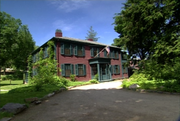Why do you bother to backfill it by hand?
Well , we place six inches of fill material over the top of the copper, by hand, Bob.
To eliminate the problem of any large stones or debris.
Perhaps, resting directly on the copper and causing it to be crimped.
So that it can be compressed and you've got (xx) that pipe.
Gook, okay.
That's correct.
And then the rest of the work is done by the machine.
Yes.
Now, you've gotten to the edge of the street, here.
We have to wait for the water department to do the rest.
Why is that?
The water department from Cambridge will do the tie to the main on the far side of the street.
Come to the sidewalk and tie into the piece I've left underneath the sidewalk.
Alright, very good.
And hopefully that on schedule for the day after tomorrow, or so
Well, while we are putting our landscape back in order, lets take to tour of the landscape at Naumkeag in Stockbridge, Massachusetts.
Watch.
We are visiting Naumkeag, in Stockbridge, Massachusetts.
Last week if you were with us, you saw the inside of this fabulous house.
Today we're getting together again with its curator Mark Bear to tour the gardens.
Hi Mark.
I can see it.
The house was inherited by the daughter.
Right, Mable Choate.
Mable Choate.
Of the Choate family.
And she is responsible for all the work on the landscape.
That's right, during her later years she designed eight acres of garden surrounding the house working with Fletcher Steele, a landscape architect from Boston.
And he was a kind of innovative guy, this is the 1920's, 1930's, he's at Harvard and he's bringing alot of new ideas in the field of landscape.
That's it exactly.
And here they had a lot of fun, Mabel Choate and Fletcher Steele both traveled through Europe so they brought a lot of those ideas back and here in the afternoon garden a center parterre of boxwood.
Contrasting borders of this coal.
And the, marble chips.
Yeah.
I am used seeing an eighteen century parterre.
Say, with a lot of bedding plants with color.
But here he's actually using minerals.
He's got crushed marble and coal.
That's right.
And what's the, the oval in the middle?
In the center, an inch thick piece of black glass to give it the sense of a very deep pool, a reflecting pool.
A place to contemplate.
It's really a marvelous effect.
And then, of course, the thing that really catches my eye, is all the red and blue tops to the posts here, that look like they're right out of Venice.
That's right.
Venice was one of Mabel Choat's favorite European cities so Fletcher Steel had a Scandinavian wood carver from his office, carve these gondola poles to remind her her of her favorite European city.
An international effort.
Right.
So where should we go from here?
Well, we can follow out, looking down.
We can follow the path of this water, as it courses it's way down the hillside.
To the Birch Walk.
Give us an idea of the size of the property here.
There are a total of fifty acres, eight of them are landscaped.
OK.
And where does wonderful path with the coursing water down the middle, where does it lead too?
This leads to the birch walk, which heads down the hill side; a series of four cascading stairs with fountains.
You never think of a landscape architect or designer having fifty acres to play with, but here he's done some specialized things, like with these trees.
That's right, these birches, which started 60 years ago, and have been inter-planted to give the sense of age also the help with the view.
Yeah, so that you've created almost a little jungle of white birch here.
What's the deal with all the step in the ramps?
The water that starts up in the afternoon garden channels down here, so below each flight of stairs there's a fountain carrying water down the hillside.
Of course, with this terrain being so hilly, we're in the Berkshires -
That's right.
- you had to do something practical in order to get down there, right?
And that's what they did.
Yeah.
But it's an unusual approach.
It's not just a staircase.
No.
There was steep a flight of stairs originally.
Aha.
They replaced it with the four flights of cascading stair.
So it's almost like a series of little belvederes .
That's right.
Each one when you stop has a closer look at the surrounding landscape.
Cutting gardens.
Yeah.
Well, that's right.
So the cutting gardens were originally down at the end but they're no more, right?
That's right.
In the green space down below.
It's really a beautiful statement, you know.
That's right with the views.
Yeah, well where to next?
How about we go see the rose garden and on the way we'll stop by the terraces.
Alright.
Numcake's built on a hill
So the idea for the landscape designer is to control it and they did that by building a series of terraces.
Now the espaliered apples look like been there for quite a few years.
Yeah, they were put in the late thirties.
So they've got some age to them.
Indeed, and of course I guess Mrs. Chote was traveling at a point in time where you could go through Europe and you could collect things like this, couldn't you?
This lead cistern from England, pick things like that up in Asia.
These oriental spirit stones.
Yeah, the spirit stone.
Okay but the cistern is actually... appeals so much to me in the garden because it's something that belongs to the house.
The down spout from the gutters of the roofs would terminate here, and this would be a collection point for water.
That's true.
And this one says 1707 isn't that wonderful.
That's great.
Yeah.
So what do we have here?
Then down below, we're looking at the rose garden.
Which took it's idea from oreintal motifs for mushrooms.
You see the curving paths represented by the marble chips and the caps of the mushrooms with the floral bundle roses filling in this whole space.
So it's a Chinese idea.
That's right.
And the hardscape, is it paved or is it just loose gravel in there.
Loose gravel held in place by rod iron strips.
OK.
It's nice that Nomcay is open to the public and we have some of the public visiting right now but tell me about this, this whole edge over here with a purple columns.
The retaining wall is made out of rod iron painted purple by flexure steel with a cypress as the wood, thick planks of cypress holding up the wall.
So, that's actually
Holding up the wall.
holding up that whole terrace above which has these beautiful vividi, this clipped of vividi's planted on it So, is this last garden that they created?
Actually the last garden, and for last 20 years of Mable Chod's life, they worked on the Chinese garden.
Uhuh.
Which is on the north-end of the house.
It combines a series of temples, one large temple with roof material imported from Peking.
Mhmm.
Surrounding that are a series of ornamental sculptures, all imported from China.
Interplanted with gingkos for shade.
There are Japanese Pedicides, a large leafed burdock root plant beneath.
We have indigenous plants like Father Hugo Rose, flowering cherries.
Some Chinese finger stones, which are water-worn stones.
Real beautiful stones, placed there for contemplation.
Magnificent effort.
Mark, thanks for the tour.
Thank you.







